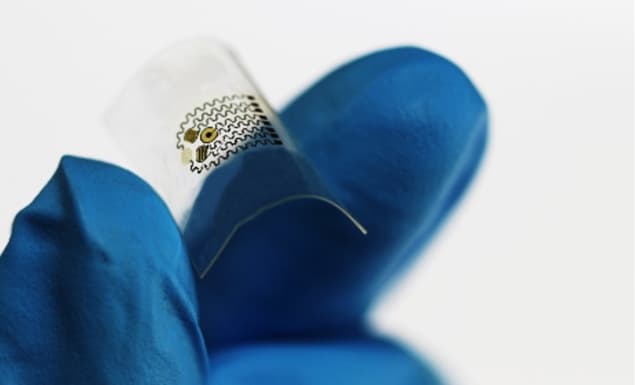
An international team of researchers has developed a novel biodegradable electronic sensor capable of measuring trace amounts of nitric oxide (NO) species. In a paper published in NPG Asia Materials, the team – from Korea University, the University of Cambridge, The Pennsylvania State University and Korea Institute of Science and Technology – outline how the implantable technology could be used to record NO concentration from the surface of organs before safely degrading into materials cleared by the body.
Nitric oxide and nitric dioxide, referred to collectively as NOx, play vital roles in vascular, nervous and respiratory health. Currently, commercial sensors monitor NOx concentration externally via exhalation. Such devices, however, may not be sensitive enough to sufficiently quantify the presence of these gases within the patient.
“It might be much more beneficial to monitor the gas levels from internal organs,” explains study author Huanyu “Larry” Cheng. Measuring NOx levels from inside the patient offers increased accuracy and sensitivity over traditional sensors.
Nevertheless, making such a device is not an easy task. The sensor must be pliable, operating under mechanical loads without compromising electrical performance. It must selectively measure NOx, even at very low concentrations. Finally, it must be removable after use. In this work, the twist – and the focus of the team headed by Chong-Yun Kang and Suk-Won Hwang – is to exploit non-toxic, biodegradable materials that are completely absorbed by the body. This means that detection is a one-and-done operation, and following implantation, no further surgery is required.
The highly flexible device uses silicon-based technology to detect NOx concentrations as low as 0.0005%. What’s more, the team determined the sensor to be 100 times more sensitive to NOx than to other well-known physiological substances – providing an edge over other promising sensors made of graphene and metal oxides.
Nitric oxide: putting the ‘NOx’ in noxious
NOx gas is a notorious air pollutant. Exposure to environmental NOx can trigger respiratory conditions such as asthma and chronic obstructive pulmonary disease (COPD). Despite this, physiological quantities of NO are critical to cardiovascular health – a discovery so important that it won the 1998 Nobel Prize for Physiology and Medicine.

Our bodies use NO as a chemical messenger, regulating blood flow to control oxygen and nutrient transport. An NO deficiency can lead to high blood pressure and the onset of atherosclerosis, or the narrowing of arteries due to fatty plaque build-up.
But NO is also toxic to nerve cells in high quantities. Excess NO production is linked to neurodegenerative conditions like Alzheimer’s disease and Parkinson’s disease.
How does the sensor work?
To create their sensor, the researchers patterned the electronic components onto a silicon nanomembrane (approximately 100 nm thick) and transfer printed them onto the biodegradable polymer poly(lactic-co-glycolic) acid (PLGA).
Silicon, as Cheng puts it, “is the building block for modern electronics”. The element is also highly sensitive to NOx. When gaseous NOx molecules adsorb onto the surface of the sensor, they deplete the top layer of electrons in the silicon. This increases the electrical resistance of the gas with respect to the baseline response (dry N2/air).
The study recognized that gas absorption is not the only parameter that affects electrical resistance. Mechanical forces can also impact how current flows through the system. If the sensor is to conform to the surfaces of different organs, it must remain functional under deformation.
A large-scale sensor array showed little change in the relative response rate when subjected to 1000 cycles of bending or stretching. Furthermore, the researchers used computer simulations to probe the stress and strain response of each layer within the device. They concluded that the array remains functional when stretched up to 40% of its length.
The team assessed the selectivity of the sensor to NOx by comparing the intensity of the resistance signal to its responses to other common gaseous biomarkers, including carbon oxides and ammonia. Not only does the technology show exceptional selectivity, but it does so incredibly quickly. When introduced to the sensor, the gas was detected in just 30 s.
Crucially, the device biodegrades over a timescale suitable for tracking a patient’s NOx levels. When submerged in a body-fluid mimic (phosphate buffered saline, pH 7.4, 37°C), all electronic components degraded to non-toxic end products in just 8 hr.
The results demonstrate that the sensor operates effectively under the harsh conditions of the body. Next, the researchers plan to look at tweaking the design to monitor other bodily functions for various disease detection applications.



